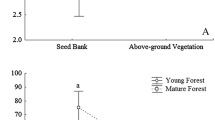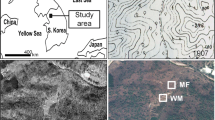Abstract
The research was conducted in two natural forest communities: Potentillo albae-Quercetum (‘oak forest’) which allows much light to reach the forest floor and Tilio-Carpinetum typicum (‘hornbeam forest’) which shades the herb layer heavily. The seed banks were estimated from numbers of seedlings emerging from soil samples over one growing season.
(1) Our results confirm the hypothesis that persistent seed banks are mainly formed by species with high light requirements. Of the species found predominantly in the seed bank and absent from the herb layer or occurring there very rarely in both communities 83% of species and 70% of seedlings were strongly light-demanding (Ellenberg's light index 6–9). However, the results do not support the hypothesis that seed banks in natural deciduous forest communities are small, poor in species and do not reflect the species composition of herb layer.
(2) The seed banks of both communities were rich in species and relatively large. Species richness in the oak forest turned out to be higher than in the hornbeam forest (51 vs 45 species/2.4 m2), but size was smaller (2659 vs 5789 seedlings/2.4 m2). In the oak forest the most abundant species in the seed bank was Galium boreale, but it constituted only 19% of the total number of seedlings, whereas in the hornbearn forest the dominant species, Urtica dioica, constituted 57% of the total.
(3) In each community the species composition of the seed bank and the herb layer was very similar (>70%).
(4) The seed bank was more diverse in the oak forest than in the hornbeam forest (H′ 2.34 vs 1.68).
(5) The seed banks of both communities differed in the contribution of species with varied light requirements; in the sunny oak forest species with high light requirements dominated, whereas in the shady hornbeam forest both strongly and moderately light-demanding species had similar contributions.
Nomenclature: Follows Ehrendorfer (1973) and Matuszkiewicz (1981).
Similar content being viewed by others
References
Beatty, S. W. 1991. Colonization dynamics in a mosaic landscape: the buried seed pool. J. Biog. 18: 553-563.
Brown, A. H. F. & Oosterhuis, L. 1981. The role of buried seed in coppicewoods. Biol. Cons. 21: 19-38.
Cook, R. 1980. The Biology of Seeds in the Soil. In: Otto T. Solbrig (ed.), Demography and Evolution in Plant Populations. Bot. Monogr. 15: 107-124.
Ehrendorfer, F. 1973. Liste der Gefäßpflanzen Mitteleuropas. G. Fisher, Stuttgart.
Falińska, K. 1978. Behaviour of Caltha palustrisL. Populations in Forest and Meadow Ecosystems of the Bialowieza National Park. Ecol. Pol. 26: 85-109.
Falińska, K. 1979. Modifications of Plant Populations in Forest Ecosystems and their Ecotones. Pol. Ecol. Stud. 5: 89-150.
Falińska, K. 1986. Demography of Iris pseudoacorusL. populations in abandoned meadows. Ecol. Pol. 34: 583-613.
Faliński, J.B. 1986. Vegetation dynamics in temperate lowland primeval forests. Ecological studies in Bialowieza forest. Geobotany 8, Dr W. Junk Publishers, Dordrecht.
Faliński, J. B., Canullo, R. & Bialy, K. 1988. Changes in herb layer, litter fall and soil properties under primary and secondary tree stands in a deciduous forest ecosystem. Phytocoenosis 1: 1-49.
Faliński, J.B. 1991. Procesy ekologiczne w zbiorowiskach leśnych. Phytocoenosis 3: 17-41.
Graber, R. E. & Thompson, D. F. 1978. Seeds in the organic layers and soil of four beech-birch-maple-stands. US Forest Service Research Paper NE 401.
Grime, J.P., Hodgson, J.G. & Hunt, R. 1988. Comparative Plant Ecology. A functional approach to common British species. Unwin Hyman, London.
Hendry, G.A.F., Thompson, K., Moss, C.J., Edwards, E. & Thorpe, P.C. 1994. Seed persistance: a correlation between seed longevity in the soil and orthodihydroxyphenol concentration. Funct. Ecol. 8: 658-664.
Hill, M.O. & Stevens, P.A. 1981. The density of viable seeds in soils of forest plantations in upland Britain. J Ecol. 69: 593-709.
Jankowska-Blaszczuk, M. & Grubb, P.J. 1997. The soil seed bank of primary and secondary deciduous forest in Bialowieza National Park, Poland. Seed Sci. Res. 7: 281-292.
Kwiatkowska, A.J. 1972. Analiza homogeniczności runa fitocenozy przy zastosowaniu nieparametrycznego testu serii. (Analysis of the homogenity of the phytocoenosis herb layer with the application of the nonparametric test of the series). Phytocoenosis 1: 37-65.
Kwiatkowska, A.J. 1986. Reconstruction of the old range and the present-day boundary of Potentillo albae-QuercetumLibb. 1933 phytocoenosis in the Bialowieza Primeval Forest landscape. Ecol. Pol. 34: 31-45.
Kwiatkowska, A.J. 1994a. Changes in the species richness, spatial pattern and species frequency associated with the decline of oak forest. Vegetatio 112: 171-180.
Kwiatkowska, A.J. 1994b. Effect of species diversity, frequency and spatial distribution on the species - area relationship in an oak forest stand. Ann. Bot. Fennici 31: 169-178.
Kwiatkowska, A.J. 1996. Zmiana presji roślinozerców jako przyczyna regresji świetlistych dąbrów w Puszczy Bialowieskiej. (The changing pressure of herbivores as the cause of decline of heliophilous oak forest in the Bialowieza Primeval Forest). Wiadomości Ekologiczne 42(3): 137-162.
Kwiatkowska, A.J. & Soliñska-Górnicka, B. 1993. Changes in typological and spatial boundaries between neighbouring communities of Potentillo albae- Quercetumand Tilio-Carpinetum. Acta Soc. Bot. Pol. 62: 59-66.
Kwiatkowska, A. J. & Wyszomirski, T. 1988. Decline of Potentillo albae-Quercetumphytocoenoses associated with the invasion of Carpinus betulus. Vegetatio 75: 49-50.
Kwiatkowska, A. J. & Wyszomirski, T. 1990. Species deletion in Potentillo albae-Quercetumphytocoenoses reversed by the removal of Carpinus betulus. Vegetatio 87: 115-126.
Kwiatkowska, A.J., Spalik, K., Michalak, E., Palińska, A. & Panufnik, D. 1997. Influence of the size and density of Carpinus betuluson the spatial distribution and rate of deletion of forest - floor species in thermophilous oak forest. Plant Ecol. 129: 1-10.
Lindacher, R. 1995. Phanart. Database of Centraleuropean Vascular Plants Explanation of Codes, Structure Contents. Veroffentichungen des Geobotanischen Institutes der ETH, Stiftung Rubel, Zürich, 125 Heft.
Livingston, R. B. & Allessio, M. L. 1968. Buried viable seeds in successional fields and forest stands, Harvard Forest, Massachusetts. Bulletin of the Torrey Botanical Club 67: 253-273.
Matuszkiewicz, W. 1981. Przewodnik do oznaczania zbiorowisk roślinnych Polski. PWN, Warszawa.
Milberg, P. 1992. Seed bank in a 35-year-old experiment with different treatments of a semi-natural grassland. Acta Oecol. 13: 743-752.
Milberg, P. 1995. Soil seed bank after eighteen years of succession from grassland to forest. Oikos 72: 3-13.
Nakagoshi, N. 1985. Buried viable seeds in temperature forest. Pp. 551-570. In: White, J. (ed.), The Population Structure of Vegetation. W. Junk Publishers, Dordrecht.
Oosting, H.F. & Humphreys, M.E. 1940. Buried viable seeds in successional series of old fields and forest soils. Bull. Torrey Bot. Club 67: 253-273.
Pickett, S.T.A. & McDonnell, M.J. 1989. Seed Bank Dynamics in Temperate Deciduous Forest. Pp. 123-147. In: Leck, M.A., Parker, V.T. & Simpson, R.L. (eds), Ecology of Soil Seed Banks. Academic Press, London.
Piroznikow, E. 1983. Seed bank in the soil of stabilized ecosystem of a deciduous forest (Tilio-Carpinetum) in Bialowieza National Park. Pol. Ecol. 31: 145-172.
Ralska-Jasiewiczowa M. & Latalowa M. 1996. Poland. In: Berglund, B.E., Birks H.J.B. M. Ralska-Jasiewiczowa, M., & Wright, H. (eds), Paleoecological events during the 15 000 years. J. Wiley & Sons, New York.
Roberts, T.L. & Vankat, J.L. 1991. Floristics at a chronosequence corresponding to old field-deciduous forest succession in south-western Ohio. II. Seed banks. Bull. Torrey Bot. Club 118(4): 377-384.
Staff, H., Jonsson, M. & Olsen, L.G. 1987. Buried germinative seeds inmature beech forests with different herbaceous vegetation and soil types. Holarctic Ecol. 10: 268-277.
Thompson, K. 1992. The functional Ecology of Seed Banks. Pp. 231-257. In: Fenner, M. (ed.), Seeds. The Ecology of Regeneration in Plant Communities. C.A.B. International Walingford Oxon.
Thompson, K. & Grime, J.P. 1979. Seasonal variation in the seed banks of herbaceous species in ten contrasting habitats. J. Ecol. 67: 893-921.
Warr, S.J., Kent, M. & Thompson, K. 1994. Seed bank composition and variability in five woodlands in south-west England. J. Biogeogr. 21: 151-168.
Author information
Authors and Affiliations
Rights and permissions
About this article
Cite this article
Jankowska-Błaszczuk, M., Kwiatkowska, A.J., Panufnik, D. et al. The size and diversity of the soil seed banks and the light requirements of the species in sunny and shady natural communities of the Białowieża Primeval Forest. Plant Ecology 136, 105–118 (1998). https://doi.org/10.1023/A:1009750201803
Issue Date:
DOI: https://doi.org/10.1023/A:1009750201803




